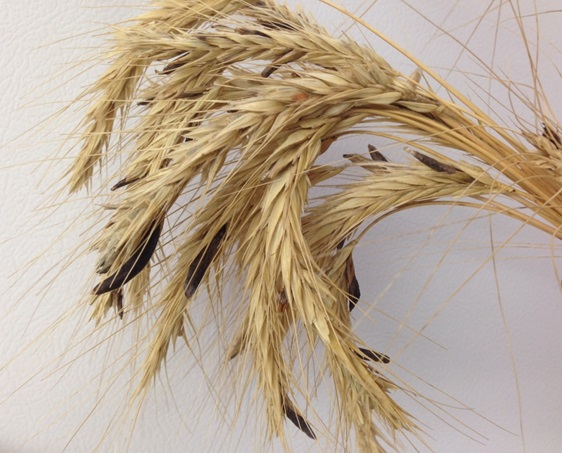Source: South Dakota State University Extension
By Emmanuel Byamukama, Extension Plant Pathologist; Ruth Beck, Extension Agronomy Field Specialist; Connie Strunk, Extension Plant Pathologist; Christopher Graham, Extension Agronomist
Ergot is showing up in South Dakota’s wheat crop this year. A fungal disease, ergot develops in the wheat head and can contaminate grain leading to rejection or dockage at the grain elevators.
The fungal pathogen that causes ergot, Claviceps purpurea, survives in grassy weeds and soil, and infects wheat through the flower. Instead of a normal wheat grain, the grain is replaced by a horn-like purple black sclerotia (Figure. 1). Ergot can cause up to 10% in direct yield losses because the grain is replaced with schlerotia.
However, the main concern is the presence of ergot bodies in harvested grain. When consumed in grain products, ergot is toxic to both humans and animals due to alkaloids produced by this fungus. Moreover, grain processing does not lower the mycotoxin level in the final product.
 Figure 1. Wheat spikes infected with ergot.
Figure 1. Wheat spikes infected with ergot.
Ergotism: Historical background
Ergotism, (also known as St. Anthony’s fire) is a disease that develops from consuming ergoty grain. This disease resulted in thousands of deaths during the Middle Ages and the 1900s. Ergotism is also believed to have been the cause of mysterious sickness in Salem, Mass., in 1692, but at the time was blamed on witchcraft. Details about the Salem witches history can be found in the PBS Ergot Poisoning - the cause of the Salem Witch Trials article. Ergotism in animals continues to be reported even today.
Ergot Thresholds in Grain
Because the ergot bodies in grain can lead to human and animal poisoning, the USDA Federal Grain Inspection Service established ergot thresholds. The grain standard threshold for ergot is by ergot weight, as a proportion of the grain weight. For wheat, the level is 0.05%; 0.1% for barley, oats and triticale; and 0.3% for rye.
The standard sample size to assess the ergot content of a load of wheat is 1,000 grams, which is about 1 quart and weighs about 2 pounds. Although the size and weight of ergot bodies vary, a general guideline is that 10 ergot bodies in a 1,000-gram sample is about 0.05% ergot by weight.
Strategies for Reducing Ergot in Grain
1. The first step is to scout the wheat field before harvesting. Ergot is mainly found in areas closer to the field borders because inoculum can come from grasses. Areas of the field that have moderate levels of ergot should be harvested last. Grain from such areas should be separated from the good grain and cleaned before blending with the rest of the grain.
2. If larger portions of the field have ergot, harvest can be delayed to increase the chance of the ergot bodies falling off the wheat heads. However, leaving the grain in the field for too long can also increase the chance of losses from hail, wind or heavy rains that may lead to lodging and sprouting.
3. Clean the seed to get rid of ergot bodies. Cleaning ergot can be challenging because ergot bodies can be the same size as wheat kernels. It may be necessary to use a gravity table to remove the ergot from the wheat.
Grain rejected at the grain elevator because of high ergot and where cleaning is not possible should be buried or burned. It should not be fed to animals because of the danger of poisoning.
Preventing Future Ergot Development
The inoculum of the ergot disease can come from grasses near the field borders, contaminated seed used for planting, or from within the field if the previous small grain crop had ergot. To minimize chances of ergot developing in future seasons, practice the following:
1. Use clean seed free of sclerotia for planting. Because ergot sclerotia can be the size of grain or even smaller, ergot bodies can contaminate seed for planting. Thoroughly cleaning the seed is required prior to planting to reduce chances of introducing the pathogen in the field. Using a triazole fungicide seed treatment will also help to reduce viability of the sclerotia.
2. Practice crop rotation. Small grain after small grain can increase ergot inoculum. Ergot sclerotia only survive for a short time, therefore, crop rotation will break the life cycle of this disease.
3. For fields with history of ergot, mow the grass around the field borders before flowering. The ergot pathogen also infects grasses and these can be a source of inoculum.






Post a comment
Report Abusive Comment